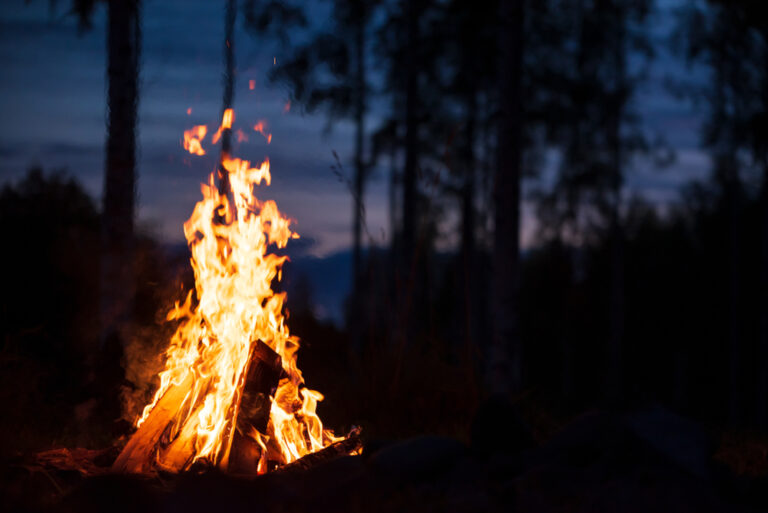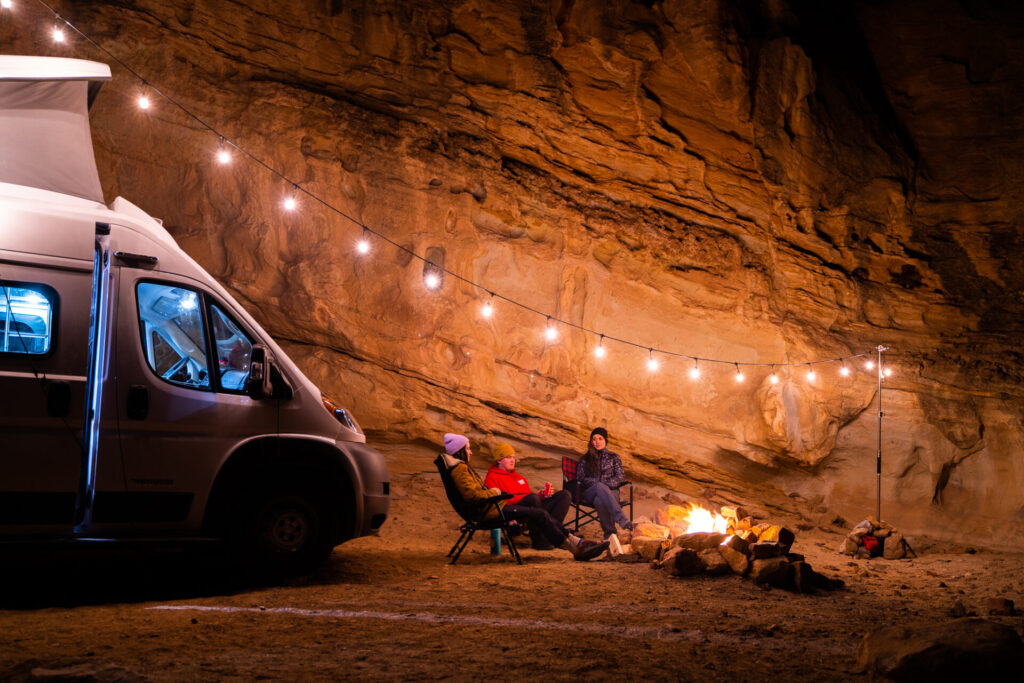
Campfires are one of the best things about camping. The crackling flames warm you on a cool summer night, give you a cozy place to chat with friends, and can even be used to cook a meal. But campfires can also cause deadly wildfires, especially in the western United States. Let’s take a look at how to safely build a campfire and then control and put it out safely.
How to Start a Campfire
How you build a campfire depends on what you want to do with it. Are you looking to keep warm? Cook dinner? Or just have a fun light source as you hang out with your friends and family and maybe roast a marshmallow or five? No matter which type of fire you’re looking to build, you’ll need a few basic items to start.
Also, before you build a campfire, make sure to have a large bucket of water and a shovel available to douse any flames.
Tinder – these are small and easily burnable materials like small wood shavings, bits of cardboard, dried leaves, wadded up paper, or store bought or homemade fire starters.
Kindling – twigs and small branches that are slightly bigger than tinder. Usually, they’re less than one inch in diameter and are placed on top of the tinder.
Firewood – split logs or whole logs, this is what keeps the fire burning. Always use locally sourced firewood. Using wood from other areas can introduce problematic insets into new forests and damage the ecosystem. Many campgrounds will have firewood for sale on site, but local stores also offer bundles for sale. If you’re boondocking and looking to gather wood from the nearby area, only gather wood from the ground and never break it off living trees. Not only is that bad for the environment but it’s also too fresh to burn properly. Many national and state parks prohibit gathering wood from the area, so always check if gathering firewood is allowed where you’re camping.
Different Types of Fires
Here are some of the most common types of campfires and how to build them.
Teepee or Cone Fire
This fire is named for its shape and is good for cooking quick things or boiling water for coffee. To build, loosely pile some tinder in the fire ring and arrange the kindling in a cone shape (like a teepee) over it. Then add another teepee of firewood around the kindling. When you light the tinder, the fire will get plenty of oxygen and rise up through the wood. Once the fire is going, you can add more firewood as needed in the teepee shape to keep the fire burning. To cook, wait until the teepee of firewood collapses and makes a bed of coals.
Log Cabin Fire
This fire is also named for its shape and burns long and hot. Place two pieces of firewood parallel to each other inside the fire ring with room in between them. Set two more pieces of firewood parallel on top of them so they make a square (like a log cabin). Add your tinder and a few pieces of kindling inside the square. Continue building up the outside “cabin” with more layers of firewood. Then light the tinder.
Platform Fire or Upside Down Pyramid
This style of fire is similar to the log cabin fire, but it burns down instead of up, which makes it a great option for cooking. The base creates a good bed of coals and you can set cast iron pans directly onto them. To build, start by laying three or more pieces of firewood on the ground beside each other. Place three more pieces of firewood perpendicularly on top of them. Add two more pieces of firewood perpendicular to that layer (so they lay the same direction as the bottom layer), and then add another two pieces of firewood perpendicularly to that layer. Finish with a pile of tinder and kindling on the top and light it. The fire will start at the top and feed its way down to the bottom.
Star Fire
Lastly, this style is great for keeping a fire going if you don’t have much firewood. To build this campfire, start by making a small teepee fire with tinder and kindling. Add five larger pieces of firewood all around it, with one of their ends in the fire and the other ends pointed away from the fire so it looks like a star. As the fire burns, push the ends of the logs into the fire to replace what has burned away.
Campfire Safety
Campfires are amazing, but they can also be dangerous and lead to deadly wildfires. Conscious campers do what they can to help prevent that by following campfire safety guidelines.
First things first, no matter if you’re staying in a campground or boondocking, always check if campfires are permitted. Fire bans may be in place, especially in the western states where drought and hot summer seasons create a high risk of wildfires. Confirm with your RV park or campground to see if fires are allowed. If you’re camping on U.S. Forest Service or BLM land, check with the local ranger station or the agency’s website to see if any fire restrictions are in place or if fire permits are needed. The U.S. Forest Service website is a great resource for the National Fire Danger Rating System.
Use established fire pits. Whether you’re in a campground or boondocking, don’t just build a fire where you feel like it. If a campground or RV park doesn’t have a fire ring at the site, the camp host or registration office will be able to tell you if campfires are allowed. When you’re out in nature, always look for an existing fire ring at a campsite or boondocking spot. If there isn’t one, it’s safer not to make a new one. It’s not allowed in many places and can damage the environment and pose a risk for wildfires if not done correctly. Play it safe and hang out inside your rig or break out a battery operated lantern for light instead.
Check the weather and surrounding vegetation. Even if there’s an established fire ring, high winds in dry conditions can blow embers into nearby grasses and ignite a fire. Make sure the area around the fire ring is clear of brush and low hanging tree branches. If a storm is brewing or it’s a windy day, skip the fire and wait for safer weather conditions.
Lastly, never leave a fire unattended. Make sure the fire is properly extinguished before going to bed or leaving the campsite. And always keep water, dirt, or sand on hand to put out the fire in an emergency.
Learn Fire Restrictions Before You Visit
Know the fire restrictions for the area where you’ll be camping before you visit. You can find many of those restrictions here on the USDA Forest Service website. If you’re camping at a national park, look for the “alert” banner at the top of the website for that park – it should give you information on any restrictions including fire-related warnings. State parks will vary, but often have any restrictions listed on their web pages. You can also check state fire websites to see if they track wildfires there. Finally, you can call the park or campground where you’ll be camping to ask about restrictions.
Often, one of the first restrictions that will go into place during high fire danger is a campfire ban. However, bans can get stricter and can extend to a complete burn ban on any outdoor flame including grilling. You’ll want to make sure you have an alternate way to prepare meals, or that you have ready-to-eat options available if you’re not allowed to have an outdoor flame. There may also be restrictions on where you can drive, or other precautions.
Punishments for violating fire bans can be severe. On the low end, you’ll likely be facing a fine that usually increases if you have more than one offense. In some cases, they can even involve jail time. It’s not something to mess around with!

Use An Active Fire Map For Planning
As you plan your trip, consult an active fire map. Knowing where fires are burning can help you choose a safer area with fewer restrictions on the activities you want to do while you’re camping. The USDA Forest Service site also has an active fire map so you can check on the area where you want to camp. You can also check the Air Quality Index here. Even if you’re not close to flames, bad air quality from smoke can affect the outdoor activities you planned to do.
Camping close to fire areas not only means you’ll likely face burn bans and other restrictions, but you may need to be ready to evacuate the area. Outdoor activities you want to do could be limited and the smoke could affect your breathing or eyes. If you’re headed to a national park or other outdoor space, that area could even be completely closed, depending on the severity of the fire. A little research ahead of time to spot the high fire danger areas, and determine whether you need to postpone your trip or pick a different destination could make your trip both safer and more pleasant.
Properly Putting out a Campfire
When you’re ready to head to bed or leave the campsite, it’s very important to put out your campfire correctly. To put out your campfire, pour water over the fire slowly to douse the embers, then stir the ashes. Repeat the steps until you’re sure the fire is completely out. To check, hold your hand close to the ashes to see if you feel any heat. If you do, keep dousing with water and stirring until you don’t feel any heat. Once you’re confident the fire is completely out, spread the ashes in the fire ring.
Using dirt or sand to put out a fire can lead to problems, since the coals can become insulated and ignite later, causing a wildfire. If you used dirt or sand to put out your fire, make sure to use the water method to fully extinguish your fire before you leave the campsite.
If you built a campfire ring yourself, be sure to take it apart before you go and scatter the rocks back near where you found them. If you built a fire in a ring provided by a campground, make sure it’s filled with wet dirt before leaving. You can find more tips for building a safe fire by reading Smokey Bear’s Campfire Safety Guide.
When is Wildfire Season?
Wildfires are typically most likely to occur from May to October, although they have started even later in the year. The East Troublesome Fire in Colorado didn’t even begin until the end of October and lasted until December when winter snow was one of the factors in getting the fire under control. In Southern California, Santa Ana winds often pick up in the fall and can lead to fires, and in 2017 a series of fires there were ignited in December.
In fact, one study showed that California’s wildfire season was actually two seasons – June through September in higher, forested areas, and October through April when fires are fueled by the Santa Ana winds and tend to threaten urban areas.
If you haven’t ever built your own campfire and would like some expert help, many outfitters like REI have classes for beginning campers where you can practice these skills.
Wildfires are a real threat and consideration when camping, and it doesn’t seem like that will change anytime soon. Hopefully, with these simple tips, you can still get outdoors, enjoy nature, and help preserve it for the next people to visit!






